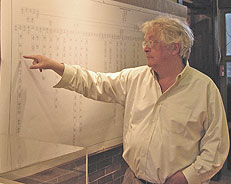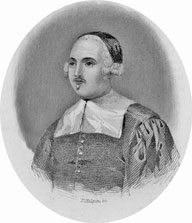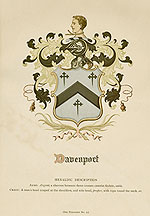The Stamford Historical Society Presents
Portrait of a Family: Stamford through the Legacy of the Davenports
John Davenport 1597–1669/70
“The Founder”
New Haven Colony began in the conscience of John Davenport. Born in 1597 in Coventry, Warwickshire, England, John Davenport attended Oxford but left before obtaining his degree, for lack of funds. He began preaching at a private chapel in Hilton Castle, near Durham, in 1615. Fours years later he was a curate at a London church when he returned to Oxford for his B.D., and was then vicar at St. Stephens in London.
Davenport had become acquainted with several Puritan families, including the Veres, which prompted opposition to his position within the church, although he proclaimed his total conformity to church doctrine. He remained with his parishioners during the great plague of 1625.
Close association with the Puritans, becoming spiritual adviser to Lady Mary Vere in 1629, led to his being condemned by higher church powers whose anti-Calvinism under Archbishop William Laud, led to Davenport’s decision to leave England. He sailed for the Netherlands in 1633 where he resided for four years. During this interval he remained in correspondence with a friend of his youth, Theophilus Eaton, a London merchant, who, like Davenport, was interested in eventually migrating to New England.
He married Elizabeth [ ] in England prior to 1619. Their son John, Jr., born in April 1635 at The Hague, later died in Boston. In 1637 the Davenports and Theophilus Eaton sailed to New England, first arriving in Boston, and then proceeding to New Haven in 1638. With Davenport as pastor and Eaton as governor, the colony began, not politically aggressive but adhering strictly to the law – first of the church, and then the colony. Here Davenport was acknowledged leader of the community, ruling his congregation with a strong hand. Since voting was limited to freemen of the church, his influence included the entire colony.
After a prolonged series of controversies within the Church at Wethersfield, Connecticut, a group of those most dissatisfied met with Pastor Davenport and Governor Eaton. The group formed a company and agreed to peacefully separate from Wethersfield and embark upon establishing a new town on land recently purchased from the Indians by the New Haven Colony. In the spring of 1641 they proceeded to this place called Rippowam, later renamed Stamford.As the movement to absorb the New Haven Colony into Connecticut grew stronger, Davenport was one of two signers of a letter to the General Court urging a delay in the action. When the proposal became reality, Davenport believed his life work was lost. Shortly thereafter he accepted a call to the pastorate of First Church in Boston, but the New Haven church was reluctant to have him leave. His endeavors for release caused dissension in the Boston church, leading to a split in the congregation which resulted in the formation of the Third Church.
John Davenport died in 1669/70 and is buried in King’s Chapel Burying Ground, Boston.
On display in the exhibit:
A Complete History of Connecticut, Civil and Ecclesiastical,
From the Emigration of Its First Planters from England, In MDCXXX, To MDCCXXIII
Benjamin Trumbull,
1797
It includes a portrait of John Davenport engraved by Amos Doolittle. Doolittle, a noted engraver, produced prints of battles at Lexington and Concord after Ralph Earl, 1775, and a great variety of maps, book illustrations, and portraits.
Loan, Pequot Library
 Stephen Rintoul Davenport III, Co-Chairman
of the exhibit, points to his family branch on the Six-Generation Descendancy Chart compiled by Robert R. Davenport. Stephen Rintoul Davenport III, Co-Chairman
of the exhibit, points to his family branch on the Six-Generation Descendancy Chart compiled by Robert R. Davenport. |


 Stephen Rintoul Davenport III, Co-Chairman
of the exhibit, points to his family branch on the Six-Generation Descendancy Chart compiled by Robert R. Davenport.
Stephen Rintoul Davenport III, Co-Chairman
of the exhibit, points to his family branch on the Six-Generation Descendancy Chart compiled by Robert R. Davenport.
